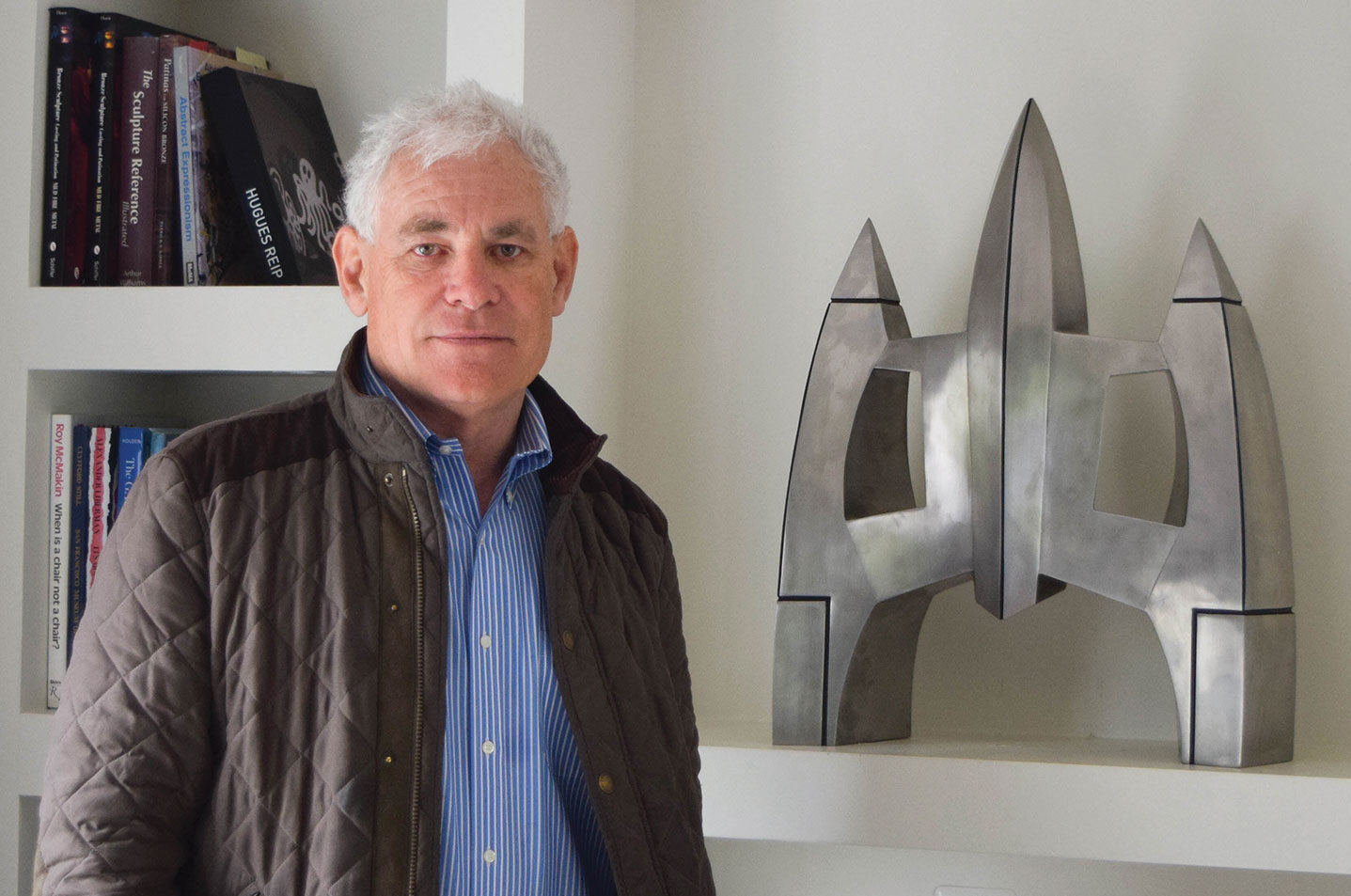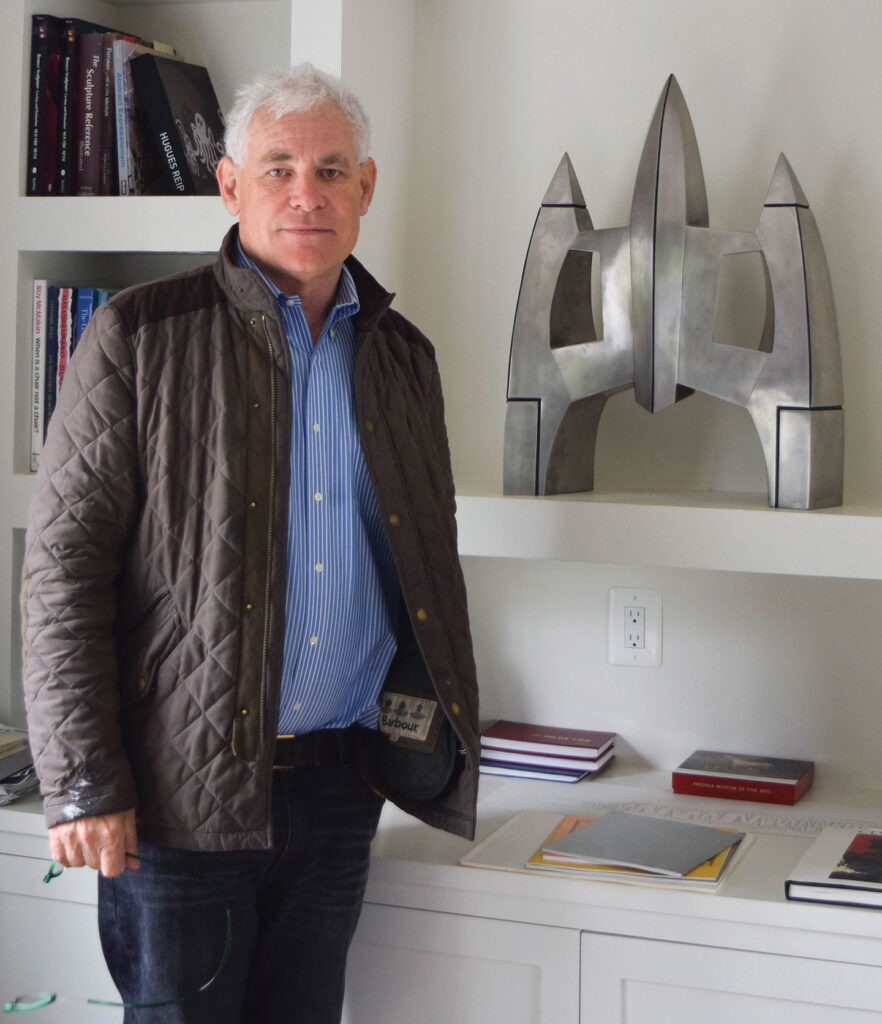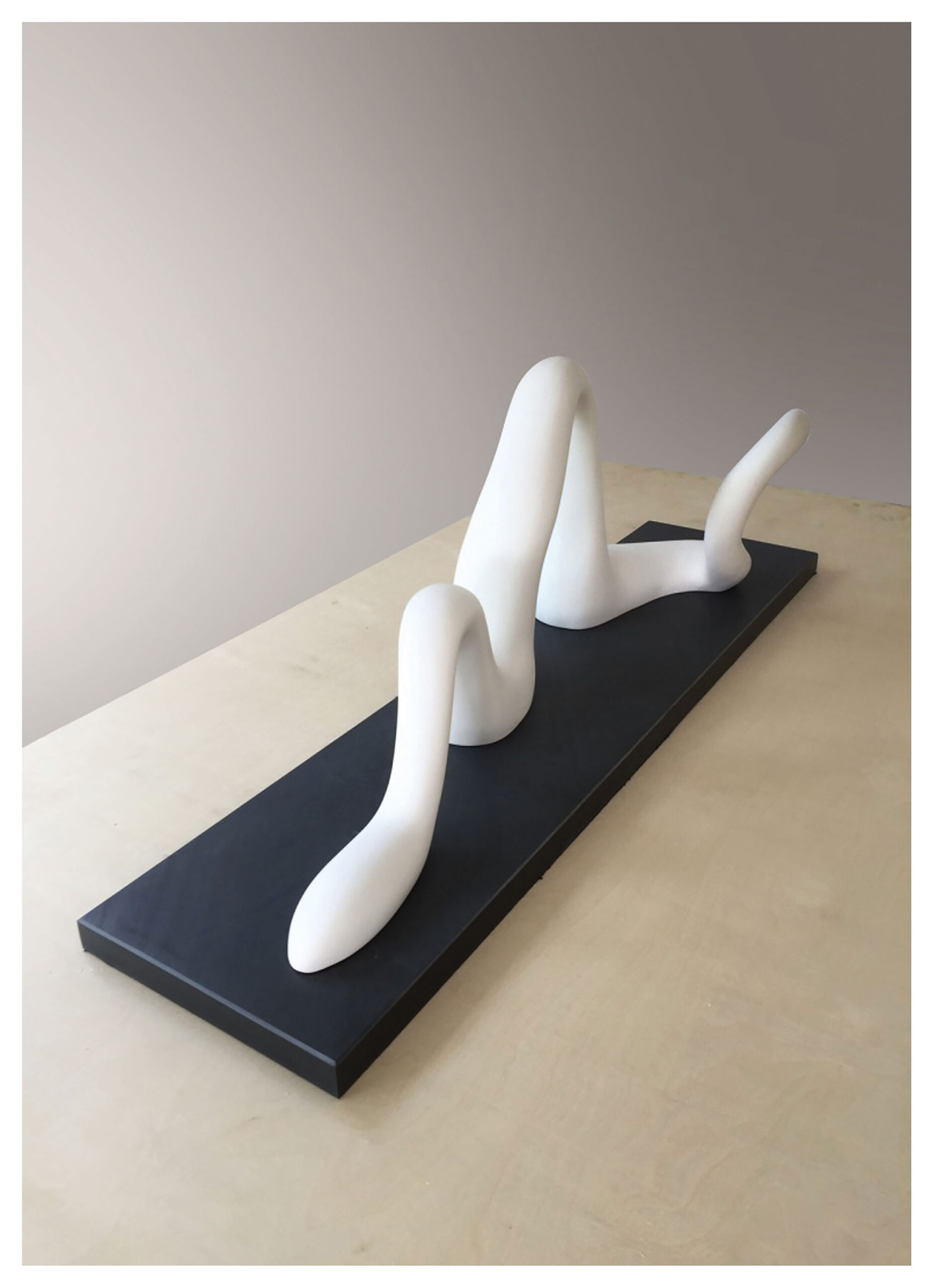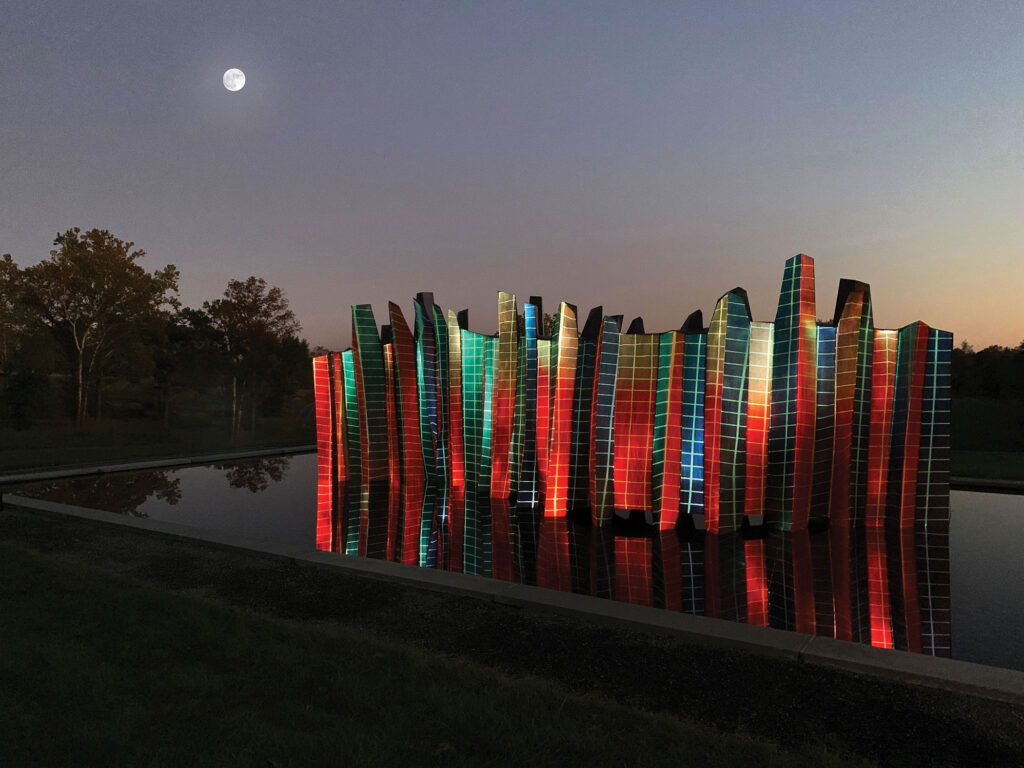Meet Your Neighbor: Inside the Mind of Hubert Phipps

Meet Your Neighbor: Inside the Mind of Hubert Phipps
Story and photos by Kaitlin Hill | Art images courtesy of Hubert Phipps
Hubert Phipps is difficult to define. A champion race car driver, seasoned pilot, and widely exhibited artist, this Hunt Country native has successfully expressed himself across a variety of mediums. His studio, just minutes from Middleburg’s main street, is a maze of newly started, semi-finished, and completed masterpieces that could broadly be designated as abstract art. But Phipps and his musing in metal, clay, pigment, and even soot, are perhaps more accurately described as transcendent, futuristic, even alien, yet still unmistakably human.
“From a very early age, I loved to draw, like so many kids,” Hubert Phipps says from the sun-soaked heart of his expansive studio. “My father was in the publishing business and he had these compendiums of political cartoons … I could transcribe drawings from. Back in the 20th century, they were very detailed, of course distorted, but I really enjoyed that. I was what one would call an illustrator.”
Though his interest and formal education in art came early, as a member of New York’s Art Students League in 1974 at age 17 and student at the San Francisco Art Institute at 21, he didn’t focus on his craft solely until later in adulthood.
“It’s not a path I dedicated myself to fully in my younger years,” he says. “I got involved in many other endeavors in life. I am a lifelong aviator. I got my student pilot’s license when I was 16. Plus, I had a career as a professional racecar driver back in the 1980s.” Phipps raced from 1980 to 1985, winning the S.C.C.A Formula Atlantic National Champion title in 1981.

Hubert Phipps, photographed by Kaitlin Hill.
In spite of his success, Phipps didn’t feel focused. “I got to a point in my life where I didn’t feel like I had a sense of direction, and I was a little scattered in terms of my level of interest or the number of interests I had in my life,” he says. “I was not very focused on one thing.”
In the early 2000s, Phipps reconnected with his adolescent interest in art. “I had never stopped doing art,” he says. “It was just always in the background or not the most important thing. Around 2002 or 2003, I decided that I was going to make a commitment to my artwork. I made the decision that this is maybe not a lifelong sentence. I’ll give it a shot and see what happens in six months, a year.”
Phipps admits that his determined rededication didn’t come without doubts.
“One of the things I really struggle with is my lack of confidence in the work that I do,” he says. “It’s a lot of self-imposed beliefs. You know, ‘You can’t really make it as an artist, your work is not good enough.’ And the competition is insane. There are so many good artists out there. I was committing myself to this, in an earnest way, rather in midlife and I thought people aren’t going to take it seriously, but that was really missing the point. For somebody to excel at whatever they do, at least my experience is, is to not be preoccupied with the results. And if it’s something you enjoy doing, do it for the enjoyment of doing it. This has been an absolute key idea that did resonate with me.”
Phipps moved back to Middleburg fulltime in 2004 and converted what was once his helicopter hanger into an artist’s space that is part-studio, part-exhibit, part-office with roughly a room semi-dedicated to each medium he works in, with some creative overlap.
His palatial stone studio with floor-to-ceiling windows is set on a sprawling lawn and surrounded by towering trees. The space and the setting speak to Phipps’ source of inspiration for the larger-than-life pieces he creates inside.
What influences his work? “The easy answer is … nature and the world of forms that we live in, man-made forms,” he says. “But it’s my interpretation and how that interpretation evolves is really interesting and is how a lot of my work is done.”
For Phipps, both his two-dimensional and three-dimensional concepts start in a sketchbook, often with something as simple as a line. “I start doing some very basic lines just to get something on the paper that just comes out of nowhere,” he says. “I get some lines down and I start fleshing out some forms. The process after that is hard to explain. In some ways, it’s blind. Then I start exploring different mediums.”
For his pure paint pigment pieces, Phipps goes in actually blind, covering his eyes and eliminating sources of light. “I’m working on a scale of 8 x 4 feet, and I cover the whole paper with this deep nano black type of a powder,” he says. “Then I start at night. I turn out the lights and if I am still getting some visual lights, I even put a blindfold on. I get down onto this paper, on my hands and knees on the floor, and I start drawing lines with an eraser.”
More than removing pigment from paper, Phipps says, “I make an effort to take out the whole conscious. I am trying to eliminate the thinking mind from the process. When I turn on the light and see what I’ve got, I finish these [works] out consciously, manipulating the pigment.”
The result? Dramatic black canvases with ghostly wisps of white that are as beautiful as they are mysterious. Their names add to their allure, with fitting titles from a 2018 installment like “Mystique,” “Crucible,” and “Momentum.”
He works in oil paint, ink, charcoal, and soot too, creating visuals that range from bold splashes of color, geometric puzzles, a quizzical self portrait (2009), and the billowing nature of smoke captured on paper, all with the shared quality of jumping off the page.
For Phipps, many of his two-dimensional renderings quite literally jump off the page, transforming into tabletop or towering sculptures.
“Once I get into projects, there are some things that are created in a two-dimensional world that I can, in my mind, imagine as 3D,” he says. “But there can be impossibilities, physical limitations to achieving what I have in my mind. And sometimes, the physical realities of making something will not achieve the aesthetic goal I have. One of the challenges is to overcome the mind’s thought of ‘this is not going to work,’ and rather, take on ‘this is not working, but if this door closes, another door opens.’”
Phipps’ ability to push through helps him produce 3D structures that are truly otherworldly and exceptionally lifelike. “Sky Temple,” a 2018 piece made from cast stainless steel, comes in at 26 x 90 x 11 inches, and looks utterly out of this world. It’s a collection of negative spaces, razor sharp edges, and purposeful points that appear poised to go intergalactic at any minute. In contrast, a white “Corian Serpent” (2018) may have just slithered in from Phipps’ backyard, characterized by its smooth skin, undulating body, and alert tail end.

A recent sculpture, “Dream Wall” (2019), transcends “the realm of physical objects.” The nine-foot-tall and 25-foot-long project is a collaboration of three artists, (Jeff Grantz, Jason Crigler, and Samo Okerstrom-Lang) three mediums (structure, light, and sound), and is the result of years of work. The piece sits outside his Middleburg studio in a pool of water, begging to be explored.

Dream Wall Colored.
Phipps landed his first exhibit in 2016. Five years later, he has solo exhibits, group exhibits, and permanent collections in Florida, New York, Colorado, Pennsylvania, Georgia, Michigan, and Massachusetts, and is planning a project, one of many, that will address the social turmoil in the country. He was recently appointed to the Board of Trustees of the Virginia Museum of Fine Arts in Richmond, Va., and is working to reimagine Richmond’s Monument Avenue.
While Phipps is certainly not slowing down, he is reflecting on the past as he looks to the future. “It’s really interesting how the passage of time helps reframe my experience and give me perspective,” he says. “I am revisiting and getting a new appreciation of how, with some adjustments or using a different track, that opens up a lot of doors and really enables a project to come alive in a different way.” ML
Learn more about Hubert Phipps at www.hubertphipps.com and on Instagram @hubertphippsstudio.


